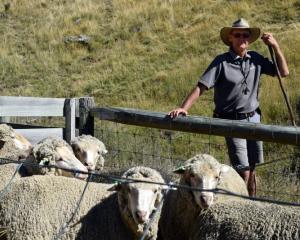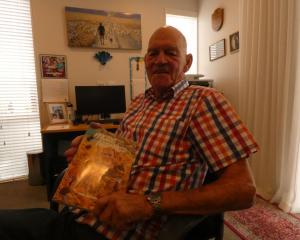
He is without doubt the elder statesman of the merino industry. At 96 and as sharp as the proverbial tack, the gentleman that is Bill Gibson reflects that he has been lucky. But in return, the fine-wool industry has been fortunate to have such a passionate and respected ambassador for the breed.
On Saturday, Bill returned to his old home Malvern Downs, now run by his son Robbie, to celebrate the family’s centennial on the Tarras property.
The milestone was marked with a gathering of family, friends and those with connections to the farming operation which is synonymous with quality merino sheep.
The many prize ribbons won over the years by Malvern Downs merinos were on display, reflecting the successes in the show ring.
Reflecting on the centennial, both father and son paid tribute to their respective mother and grandmother, saying without her the property might not have remained in Gibson family ownership.
While the official anniversary was in April this year, that was a busy time but Robbie Gibson said they got thinking about it and decided it was an occasion worth celebrating.
And as Bill Gibson began sorting through old photographs and memorabilia at his Wānaka home, his enthusiasm for such an event became infectious.
Malvern Downs, near the Tarras township, was part of the massive Morven Hills station, in the Lindis Pass, until 1880 when it was subdivided and owned by John McRae.
In 1910, R. K. Smith — who had managed Morven Hills since 1906 — bought the property which was then known as Beauly Farm. It was renamed Malvern Downs by his wife Elizabeth. He owned large tracts of land in the district but sold it all in 1924.
Hector Gibson — Bill’s father — had previously bought Morven Hills with his friend and mustering mate George Henderson in 1916, the pair then promptly went off to serve in World War 1.
Both returned from the war.
Hector married in 1925 but, 13 years later, his wife Eileen was widowed when he died from a blood clot.
As well as caring for two children — Bill was 9 when his father died — she cooked for three men without electricity and had a large landholding with a huge mortgage.
"When my father died, she could have got up, sold the two properties and moved away to town and I’d be sweeping the streets today," Bill said.
"She could have come out of it but thank God she hung on and that’s why we’re here today."
Managers were employed and there was one who Bill remembered as being very kind but knew nothing about stud merinos.
The oldest merino stud in Otago, Malvern Downs was established by Hector in 1924 with the purchase of 204 ewes, 14 ewe lambs, 57 ram lambs and three rams from R. K. Smith.
Bill came home from school, admitting he also knew nothing about stud merinos, and the manager allowed him to mate the ewes at Malvern Downs in 1945. He continued to mate the ewes every year until Robbie took over in 1980.
In 1949, Bill went to Australia to work as a jackaroo at Boonoke, near Narrandera in southern New South Wales. It was the world’s largest merino stud, selling 10,500 rams at that time.
It was a great experience for the young farmer, particularly given the scale and the prominence of the operation. Bill recalled loading a road-train with other jackaroos with 1700 rams.
"From a little dunghill here in Tarras, to that, was so different," he said.
It was also where he encountered poll merino sheep. The story was that stud master Otway Falkiner — one of Australia’s great sheep breeders — returned from the Royal Sydney Show in 1935 and commented that if horns could be bred off Hereford cattle, then he could breed them off merino rams.
Returning to New Zealand, Bill wrote to Mr Falkiner in 1950, wanting to buy a ram. He still has the type-written reply, in which the great studmaster said how he had picked "a very nice sheep" to be shipped to New Zealand and transported on to Tarras.
He added they were having a very good season at Boonoke, having broken all previous records — selling 12,041 rams for the 12 months.
While their wool sold well, they had struck a bad sale at Melbourne and the price had gone up about 25% since. They had 2500 bales of wool and must have lost about £75,000 (about $NZ5.1m today) — "a nice cheque" as he wrote. As it was, they got paid £144,000.
That year, Bill registered New Zealand’s first poll merino stud, the start of poll merinos in the country.
He recalled how it was a "pretty hard road to hoe" to start with as most high country farmers looked at a merino — "and he had to have horns". But now there were more poll studs than horned — "the pendulum has swung", he said.
Bill took over running Malvern Downs in 1953, the same year he married Frances (nee Jenkins), his wife of 71 years who was brought up on nearby Cluden Station.
His late sister Madge married Max Snow and the couple ran Morven Hills.
Rams had been bred at Malvern Downs before the property was known as Malvern Downs and Bill recalled how he was "so determined" to continue breeding sheep because his father did it before him.
Despite being young when his father died, he did have some memories of Hector and recalled that he was a "bit of a trick".
He had a dog called Pierrot and in his own decades as secretary of the Tarras Collie Club, Bill had never heard of a dog called that. He also had a ram called Bushwhacker.
It was a pity his father had not lived longer; his son believed the war caught up on him. He had bad legs, no doubt caused by being in the trenches in France.
The Gibson family’s association with the famed Merryville merino stud in Australia dated back to Bill’s trip across the Tasman in 1949.
In 1954, Bill wrote to Walter Merriman — knighted that same year for his services to the Australian wool industry — and described what sort of ram he would like to buy. The ram duly arrived and was named Sir Frances, after his wife.
Sir Walter started the Merryville stud in 1903 with a small flock of sheep from the Ravensworth stud founded by his father George in 1865.
The Merryville sheep were a type that did well in Otago and the stud’s bloodlines remained in New Zealand. Wal Merriman — grandson of Sir Walter — attended the Malvern Downs celebration at the weekend.
Bill’s accolades in the sector have been many — from a Royal Agricultural Society medal to an MBE for services to agriculture and the merino industry, and the Heather Perriam Memorial Trophy
He has judged five times in Australia but one of his greatest highlights was being asked to judge at the World Merino Conference in South Africa.
Another highlight was to win all three merino ram championships — for fine, medium and strong micron sheep — at The Christchurch Show in 1964, 1965 and 1969, the three-peat never being repeated since.
While there was "a bit of work" involved in showing, Bill also had a lot of fun exhibiting his sheep and met a lot of people.
"While you’re also all opposition ... at the end of the day, you go and have a beer with them. That, to me, is stud breeding," he said.
"With showing, you take the good with the bad. Sometimes you win with a sheep you don’t expect, you’ve got to be able to take it if you get beaten."
The Gibson family were stalwarts of the Wānaka A&P Show and Bill was delighted to see the enduring popularity of the show which draws thousands of visitors to the town every year.
Bill acknowledged the young men who had worked at Malvern Downs over the years, arriving from studying at Lincoln and Telford.
Then there was the South African lad whose father was a merino breeder who visited Malvern Downs and, prior to leaving, asked Bill if he would take his son for a season.
The father later told Bill "I sent you a monkey and you sent me back a man".
"I was very pleased with that," Bill reflected.
From driving two horses pulling a mower when he first left school, to the later advances in technology, Bill had seen many changes during his life.
One of his interests had been making walking sticks, using the horns from merinos. He made about 10 a year for 30 years and added to his own collection every time he went overseas.
He was a life member of the Scottish Stick-Makers Association.
The years on the farm had been "wonderful".
"We had good years and bad years, just like any other farming" — and it had been a "great journey".
"I’m a lucky fellow," he said.















